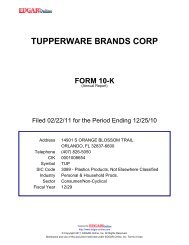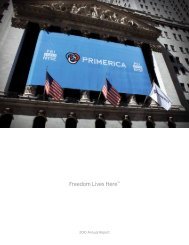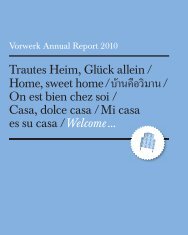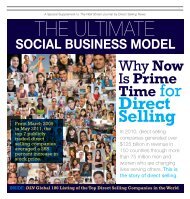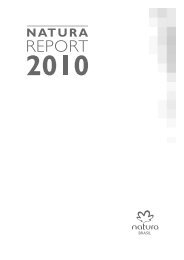Nu Skin 2010 Annual Report - Direct Selling News
Nu Skin 2010 Annual Report - Direct Selling News
Nu Skin 2010 Annual Report - Direct Selling News
Create successful ePaper yourself
Turn your PDF publications into a flip-book with our unique Google optimized e-Paper software.
consumption taxes based on an audit of the period of November 2008<br />
through September 2009. With this assessment, we have been required<br />
to pay or hold in bond amounts for all periods from October 2006 to<br />
present and we believe that additional assessments related to any prior<br />
period would be barred by applicable statutes of limitations. In July<br />
2005, we changed our operating structure in Japan and believed that<br />
these changes would eliminate further valuation disputes with Yokohama<br />
Customs as the new structure eliminated the issues that were the<br />
basis of the litigation in the first dispute (i.e., whether our US subsidiary<br />
was acting as an agent for our Japan subsidiary or was acting as the<br />
seller). However, in October 2009 we received notice from Yokohama<br />
Customs authorities that they were assessing additional duties, penalties<br />
and interest for the period of October 2006 through November<br />
2008 based on their view that we were not utilizing the proper valuation<br />
method. The basis for such additional assessment is different from the<br />
issues that are being litigated in the first dispute. The issue in this second<br />
case is whether a US entity utilizing a commissionaire agent in Japan<br />
to import its products can use the manufacturer’s invoice or must use<br />
another valuation method, and, if an alternative method must be used,<br />
what the allowable deductions would be in determining the proper<br />
valuation. Following our review of the assessments and after consulting<br />
with our legal and customs advisors, we believe that the additional assessments<br />
are improper and are not supported by applicable customs<br />
laws. We filed letters of protest with Yokohama Customs, which were<br />
rejected. We have appealed the matter to the Ministry of Finance in<br />
Japan. In addition, we are currently being required to post a bond or<br />
make a deposit equal to the difference between our declared duties and<br />
the amount the customs authorities have determined we should be<br />
paying on all current imports. Because we believe that the higher rate<br />
determined by the customs authorities is an improper application of the<br />
regulations, we are currently expensing the portion of the duties we<br />
believe is supported under applicable customs law, and recording the<br />
additional deposit or payment as a receivable within long-term assets<br />
in our consolidated financial statements. To the extent that we are unsuccessful<br />
in recovering the amounts assessed and paid or held in bond,<br />
we will likely be required to record an expense for the full amount of the<br />
disputed assessments, or $32.1 million as of December 31, <strong>2010</strong>.<br />
ITEM 4.<br />
[REMOVED AND RESERVED]<br />
PART II<br />
ITEM 5.<br />
MARKET FOR REGISTRANT’S<br />
COMMON EQUITY, RELATED<br />
STOCKHOLDER MATTERS AND<br />
ISSUER PURCHASES OF EQUITY<br />
SECURITIES<br />
Our Class A common stock is listed on the New York Stock Exchange<br />
(“NYSE”) and trades under the symbol “NUS.” The following<br />
table is based upon the information available to us and sets forth<br />
the range of the high and low sales prices for our Class A common<br />
stock for the quarterly periods during 2009 and <strong>2010</strong> based upon<br />
quotations on the NYSE.<br />
Quarter Ended High Low<br />
March 31, 2009 . . . . . . . . . . . . . $ 11.56 $ 7.90<br />
June 30, 2009 . . . . . . . . . . . . . . 15.70 10.05<br />
September 30, 2009. . . . . . . . 18.80 14.69<br />
December 31, 2009 . . . . . . . . . 28.78 18.23<br />
Quarter Ended High Low<br />
March 31, <strong>2010</strong> . . . . . . . . . . . . . . $ 30.23 $ 22.86<br />
June 30, <strong>2010</strong> . . . . . . . . . . . . . . . 33.99 23.12<br />
September 30, <strong>2010</strong> . . . . . . . . 29.87 23.55<br />
December 31, <strong>2010</strong> . . . . . . . . . 32.72 28.24<br />
The market price of our Class A common stock is subject to<br />
significant fluctuations in response to variations in our quarterly operating<br />
results, general trends in the market for our products and product<br />
candidates, economic and currency exchange issues in the foreign<br />
markets in which we operate and other factors, many of which<br />
are not within our control. In addition, broad market fluctuations, as<br />
well as general economic, business, regulatory and political conditions<br />
may adversely affect the market for our Class A common stock,<br />
regardless of our actual or projected performance.<br />
The closing price of our Class A common stock on February 1,<br />
2011, was $31.21. The approximate number of holders of record of our<br />
Class A common stock as of February 1, 2011 was 626. This number of<br />
holders of record does not represent the actual number of beneficial<br />
owners of shares of our Class A common stock because shares are<br />
frequently held in “street name” by securities dealers and others for the<br />
benefit of individual owners who have the right to vote their shares.<br />
DIVIDENDS<br />
We declared and paid a $0.115 per share dividend for Class A common<br />
stock in March, June, September and December of 2009, and a<br />
$0.125 per share quarterly dividend for Class A common stock in March,<br />
June, September and December of <strong>2010</strong>. The board of directors has<br />
approved an increased quarterly cash dividend of $0.135 per share of<br />
Class A common stock to be paid on March 16, 2011, to stockholders of<br />
record on February 25, 2011. <strong>Annual</strong>ly, this would increase the dividend<br />
to $0.54 from $0.50 in the prior year. Management believes that cash<br />
flows from operations will be sufficient to fund this and future dividend<br />
payments, if any.<br />
31



